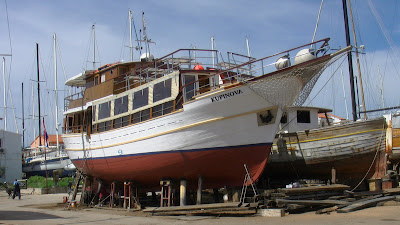 |
| Kupinova's port bow during works |
For a start, here's a little glossary of this profession's unique expressions:
Madijer - individual plank which forms outer hull of the ship
Kimenat - space between madijers
Stupar - skilled workman which fills kiments with ropes and stupa
Ponat - raw planks of different sizes from which madijers are cut out
Kolumba (Kobilica) - keel, the lowest part of the ship, massive row which connects and holds planking and the ribs of the ship - the backbone of the ship
Broke - one of many expressions for nails, those which hold madijers in their places in this example
Koper - finishing and the most resistant paint which is used to paint the lower part of the ship
Laptop - irreplaceable tool in works under and around the ship - a box which holds tools and can serve as a chair
 |
| Works after removing worn-out brokas |
After the preparations for new madijers, the space is measured, and with those measures workmen can look for a suitable ponat from which they will cut the madijer. Ponat must be of the suitable size and length, and free of worms, termites, holes, it mustn't be deeply damaged or have unsuitable lines inside. Special attention must be put to those lines going through the length of the wood. If they are badly placed, the piece of wood could break during further work. When, finally, the suitable piece is found, it is first being sketched by the measures and the then it is sawed to approximate size (notice - madijers are rarely shorter than 3 meters, so sawing of each piece requires team work of at least three people). When madijer is cut to its approximate size, it is then meticulously processed to its final and desired size.
None of the madijers is completely narrow and straight as it follows curved lines of the ship. Therefore, it is necessary to curve it - more or less, depending on its position in the hull. Curved form comes from heating - with the open flame or by cooking it. Cooking is performed by keeping the madijer in a long narrow tube filled with fresh water while under the tube a fire is kept - for at least half a day. After that kind of processing, madijer is ready for incurvation and it is placed on its designated place on the hull. It is left there until the next day so it would cool and form into desired shape in the process.
 |
| Preparations for new madijers |
 |
| During one of many cookings |
 |
| Some of many many nails that needed to be processed |
During hammering, zinc protection of the nails is damaged and it is necessary to renew it - especially on the head of the nail. The simplest way to do this is galvanizing them with spray. After putting on new zinc with spray, it is left to dry before further work. Until you finish spraying each hole from bow to stern, those in the front are already completely dry so you can start with another assignment. That is filling the holes with base paint and after it has dried, each hole has to be completely filled with putty (once again - just when you finish with one work, you can go on the beginning of the ship an start with another).
 | ||||
| Vedran is filling kiments with paint while sitting on laptop |
Painting of the underwater part of Kupinova is done in three parts: first, there is a layer of red base color which is followed by a layer of silver underwater primer. In the end, two layers of koper of pale red color are put on the entire surface of the underwater part of the ship.
 |
| Kiments partially filled with stupa |
 |
| Painting of koper on the hull |
 |
| Mostly finished Kupinova awaits return to the sea |











